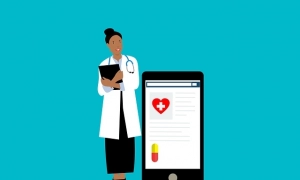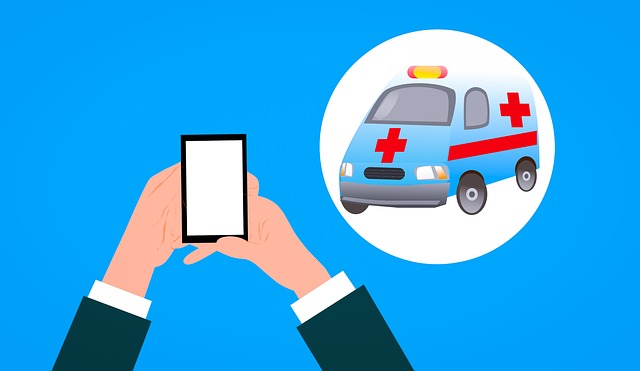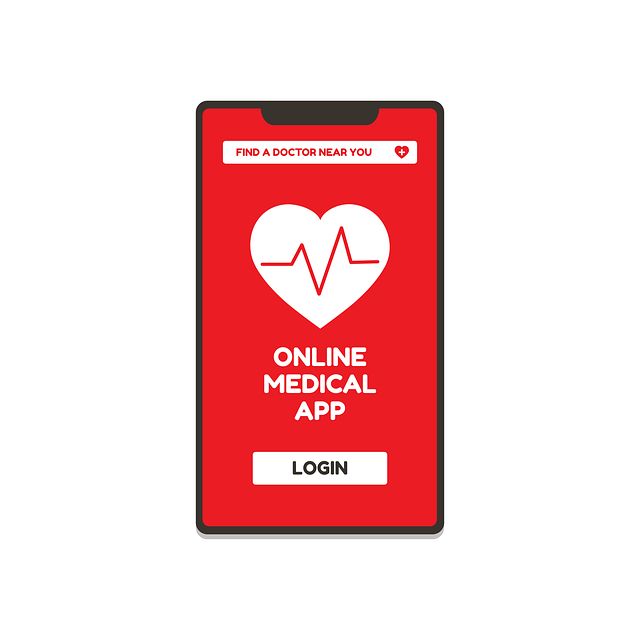
Today, more than 60% of mobile phone users are using a device that came with a healthcare app pre-installed at the time of purchase. This number is hardly surprising. For example, it is now more than 7 years since Apple first introduced its mobile Health app, which was part of the launch of the Apple Watch. One of the selling points of the watch was that it had the ability to capture the wearer’s heart rate. The data collected by Apple Watch needed to be stored somewhere - and so the companion Health app was created. In the years since, the competition for how to develop a healthcare app has only become stronger.
At that point in time, mobile phone users were already well accustomed to using applications. But, suddenly, there was an application that came included by default that focused on personal well-being and general health. Originally conceived as a little digital warehouse to store this data, work began on how to create a medical app with increased functionality.
Today, practically any field in any industry that you can think of is going mobile, and that increasingly has included healthcare. Since 2014, there had already been a surge in the developments of healthcare applications. The emergence of the COVID pandemic in 2020 has only made the subject of how to develop a healthcare app more urgent - and more widespread.
With the advances in technology and the health crisis around the world almost running parallel with each other, both medical staff and patients have been looking for ways to remain in communication with each other while simultaneously keeping a safe distance.
COVID-19 has kept people indoors. This has in turn limited people's options relating to personal health. It was inevitable that people would turn more and more towards healthcare applications to track their well-being - be it heart rates to pill control, and keeping track of prescription refill needs.
The pandemic has forced services within many industry sectors to become more digitized than they were before it, and arguably, none more so than the healthcare sector. The pandemic has also increased the demand to make a medical app relevant to the global health crisis.
Before we look at how to create a medical app, let’s first take a quick look at the specific types of healthcare apps that are on the market.
Medical App Types
When developing a healthcare app designed for an individual's personal use, the criteria to be covered can range from general overall wellness to more serious specifics.
Fitness apps
Fitness apps provide general, personalized guidance for those embarking on becoming more physically active. With the use of this type of app, progress can be measured and charted during activities such as running, jogging, gym workouts, biking, and swimming. Some of these apps can be especially helpful to those who don’t have access to actual gyms or prefer not to use them. Yoga - and even meditation - can also fall into this category.
Lifestyle Tracking and Monitoring
This type of app tends to be more analytical of user health and fitness. They are designed to track metrics such as heart rate, calorie intake, general fitness level, and sleep. For women, these apps can also incorporate the monitoring and tracking of menstrual cycles and pregnancy. There are also apps especially tailored for women that are just for these purposes. For those with serious conditions that require daily monitoring, such as diabetes, this form of an app can prove to be very beneficial.
With the medical field being the size that it is, added to the options available for app deployment, there is a lot of room for maneuver and areas to target precisely.
As examples, you could possibly elect to look into the following:
- How to build an Android app for medical research;
- How to build a medical scheduling app on iOS;
- How to make a mobile app for medical protocols;
- How to build a mobile healthcare app that sends medication alerts;
- How much would it cost to build a medical app for Junior Doctors.
As you can see, there is a very, very wide scope for potential.
The overall variety of healthcare applications that are available can be broken down into three basic categories: patients, medical staff, and administrative staff. Knowing which of these areas your app will be focusing on is important to determine before you begin the development of your app.
Here below is a breakdown of some of the most common elements that each of the three categories can cover.
For patients:
- General fitness and wellness;
- Appointment scheduling;
- Appointment reminders;
- Self-diagnostics;
- Habit tracking;
- Medical product services;
- Medication control: time-table and scheduling;
- Mental health tracking;
- Women’s health issues.
For medical staff:
- Medicinal reference and guides;
- Monitoring of patients remotely;
- Clinical communications;
- Diagnosis;
- Telemedicine;
- Appointment timetables;
- Appointment management.
For administrative staff:
- Doctor availability;
- Nurse availability;
- Appointment scheduling;
- Billing management;
- Medical supply management;
- Department activity tracking.
How to Create a Medical App: The Must-have Features
The precise nature of features included within your app will of course be determined by the user audience you are aiming for. As with an app of any type, to begin with, it will need to be engaging in order for people to want to use it. It will also need to be seen to provide the user with something that they find benefits them and justifies their reason for acquiring it.

Regardless of the specifics though, there are a number of features that are must-haves in order to create a successful app.
Build a Secure App: User Profile / HIPPA Compliance
To start with the basics, you need to provide the ability to create a user profile. From there, users can input vital information. In order for any health-related app to be of genuine benefit, users will be required to provide accurate, personal details. So it is important to provide users with full control of the personal data that the app is able to access and the manner in which it handles it.
Basic info includes name, age, height, and weight. Further information can also include relevant lifestyle questions such as; is the user a smoker? A drinker? If so, how much per day or per week? Basic but private information such as this is necessary to yield accurate data in return from the application. But be mindful. People are increasingly wary of privacy issues. So you will want to ensure that your app is not going to forward any user data without permission.
As the developer of an app that is designed around a user's confidential information, you will need to include elements such as two-factor authentication and data encryption so as to reassure your users that their information is secured.
The building of a secure medical app should be at the forefront of development.
A Tidy Dashboard
Everybody likes an easy-to-use interface and a clear dashboard. This is especially important for any health-related application. Providing clarity with an overview of a user's health, progress, history, or activity schedule is essential. The last thing you want with a medical app is to confuse its users. Quick, clear access to health metrics and other summaries is far more likely to engage users and keep them using the application than a convoluted chart that is hard to find.
Notifications
Unlike the first health app to appear on screens of Apple users back in 2014, healthcare apps on all operating systems now are interactive - not passive. They work from the input of the user. Reminder notifications are a simple way of keeping users on track. Whether it's a medication schedule, an exercise regimen, an appointment reminder, a simple notification can go a long way to aiding the maintaining of a course of action.
Secure Payment
Unless you are providing your app for free, you will need to put in place a simple process with which to make payment - whether it’s on a one-off basis or a subscription. Just as with the user profile, you will have to make sure that the security of financial transactions is watertight and you are not putting your user’s info at risk of exposure.
Analytics
In order to optimize the working of the app and thereby make it the best that you can for its users, you will need to have integrated analytical software. Before collecting even a scrap of any confidential information from users, it is imperative to ask for their permission first. Be clear as to why you are asking.
Integrate with Other Health Apps
The vast majority of medical-based healthcare applications will have to handle patient information at some time or other. Services such as Google Fit, Samsung Health, and Healthkit can be integrated and used as storage hubs to keep information together and easily findable.
Telemedicine
It wasn’t long ago that the thought of consulting with a medical professional remotely via a video link didn’t seem possible - or normal. Today, it’s common practice. More than that, with the pandemic still affecting our day-to-day lives, it has become a necessity. With all that being the case, a medical app will need the ability to supply remote yet ‘face-to-face’ consultation.
Contact List
Whether the application is designed for patients or for doctors, an easily accessible library of profiles is a must. With the addition of one of these, patients will have the ability to find the doctor and/or specialist they need as soon as they need them. These profiles need to be editable, so as to be able to include contact numbers and location details.
Though not necessarily essential, dependent on the aim of the app, other features to consider include:
- Diagnosis chatbots;
- Mobile medication alerts;
- Phone-to-text capabilities;
- Geolocation or geofencing.
How to Create a Medical App in 5 Steps
Now that you know some of the essential features that you will need to include with your application, here are the steps you need to take to create the app itself.
1. Know Your Audience
There are thousands of healthcare and medical apps on the market. To reach the people your solution is designed for will require a lot of research. Find out what it is your target audience wants from a mobile app.
If they have already used a medical app:
- What was it they liked about it?
- What did they dislike?
- Which features were absent that they wish had been included?
- Which features were surplus to any requirement?
- In which areas did the app work best?
As important as it is to know what it is that your potential users want and need, it is just as important to be aware of the contexts within which the doctor or the patient are likely to be using your app.
- Will they be standing, seated, or lying down?
- Are they able to use one or both hands?
- Will they be able to look at the screen for only a short time?
- During any screen-time, to what extent can they be expected to interact?
- How easy will it be able to utilize the app in urgency?
2. Pre-Development
When you are settled on the type of application you wish to create, for whom it is intended, the next step is to determine the tools and technologies that will be required to create a medical app. You will also need to decide upon the professional development team, should you need one, the overall costs, and what your budget ceiling is.
As well as this, you will need to decide upon the operating systems with which you wish your app to be able to run: iOS, Android, Microsoft, and so on. From there, you will subsequently need to determine devices, such as smartphones, tablets, and desktops.
3. Development
With the right tools gathered together and the right people to help, this is where the hard work comes in - and the stress. But there is a way in which this can be minimized.
Tip: With a tool such as Balsamiq or Adobe XD, you will be able to prototype your app. By doing this, you can build a mock-up of your app that is fully clickable and will look very much as the actual end product will. The building of a prototype can be hugely beneficial as you will be able to try it out on your phone, the application acting as it would once it has been finalized.
Additionally, with a prototype available, you can then have others test it for you and get real feedback on where it is working well and where it needs to have the screws tightened. Further to this, you can have your prototype tested across various platforms and devices and really get it shaped to fit accordingly to each one.
Not only is prototyping advantageous to testing the app itself and on a variety of platforms and devices, but it can save you money. It costs a whole lot more to fix problems during the development of an app than it does to fix them during the prototype stage.
4. Quality Control
For all the testing and re-testing that was performed during prototyping and development, once complete, your app will need more testing. This is necessary for any solution before its release but is even more crucial for something as serious and consequential as a medical app. Just as with proofreading an essay or a novel, there are always little details missing that need to be corrected. Just like driving a car no matter how good a driver you are, there is always a blind spot. So you will need to get quality assurance for your shiny and fresh new app. Once this is done and any issues have been rounded up and fixed can you finally let your app off the leash.
5. Release and Support
It’s no different for a healthcare app developer than for any other application developer: Once you have released your creation, you will need to continue to support it. That means updating it organically as required during its lifetime, as well as making any adjustments due to operating system updates of the platforms that carry it.
How Much Will it Cost to Create a Medical App?
There is no way in which an estimate can fairly be given. There is such a huge number of variables to medical apps and approaches to them that is impossible to nail down a price window. Apps focused on specific areas will all have specific priority features and potential requirements. The sheer scope of possibilities for apps within the medical field is near infinite.
For a very minimal app with just basic features, you could be looking at a price tag of around $25,000 to $30,00. Once things get a little more specific and complex though, the costs can jump much higher. A simple medication-scheduling pill-reminder app could set you back twice that amount. Complex apps that are multi-functional can begin at approximately that cost, and for a full practice management application, you shouldn’t be surprised to find yourself staring into a price tag of well over $250,000.
Important to remember when looking at the costs of developing a medical app is that the costs don’t stop once the application has been sent out into the world. Ongoing development, support, and adjustments mean ongoing costs.
How to Create a Medical App: Conclusion

How to create a unique medical app? With the market already saturated, then the race to build healthcare mobile apps even more prescient in the last two years, it can seem like a daunting task - but it’s not an impossible one. There are more tools and bells and whistles than ever before to create a medical app that is as engaging as it is functional and original.
FAQ
How to design an app for a medical services patient portal?
Identify your target audience and then identify their needs and the context within which they are likely to use your app. And keep it secure.
What does it cost to create a healthcare mobile app for healthcare providers?
At the very least, you should expect to be looking at a price of around $25,000. That would be for the most basic of apps. For more robust apps incorporating richer features and increased functionality don’t be surprised to be looking at $100,000 upward.
How to design a web app for owners and medical reps?
First and foremost is research. Once you have accumulated enough data to confidently continue with the enlisting of a development team, a prototype can be created, from which the final finished app will emerge.
How much do medical apps make from in-app purchases?
It can be hard to nail down an exact figure due to there being so many branches attached to the medical app tree. Combine that with the fact there are so many variations to what extras are purchasable. The popularity of particular apps is also a factor as user numbers will of course impact sales. As it is, generally speaking, the top 800 apps at any given time make around $4,000 per day.


